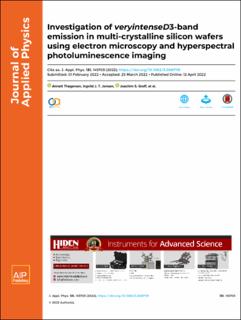| dc.contributor.author | Thøgersen, Annett | |
| dc.contributor.author | Jensen, Ingvild Julie Thue | |
| dc.contributor.author | Graff, Joachim Seland | |
| dc.contributor.author | Ringdalen, Inga Gudem | |
| dc.contributor.author | Almeida Carvalho, Patricia | |
| dc.contributor.author | Mehl, Torbjørn | |
| dc.contributor.author | Zhu, Junjie | |
| dc.contributor.author | Burud, Ingunn | |
| dc.contributor.author | Olsen, Espen | |
| dc.contributor.author | Søndenå, Rune | |
| dc.date.accessioned | 2022-05-04T12:58:45Z | |
| dc.date.available | 2022-05-04T12:58:45Z | |
| dc.date.created | 2022-04-27T19:16:42Z | |
| dc.date.issued | 2022 | |
| dc.identifier.citation | Journal of Applied Physics. 2022, 131(14). | en_US |
| dc.identifier.issn | 0021-8979 | |
| dc.identifier.uri | https://hdl.handle.net/11250/2994219 | |
| dc.description.abstract | Defects in high performance multi-crystalline silicon wafers can be detrimental to the lifetime of the solar cell. It is, therefore, important to study and understand the underlying structure and chemical elements present at these defective areas in order to suppress them. The underlying cause of the D-band emission line "veryintenseD3" (VID3) has not yet been understood, although many theories have been proposed. In this paper, we have investigated the underlying causes of the d-band emission peak VID3 by hyperspectral photoluminescence imaging, scanning electron microscopy, electron backscatter diffraction, scanning transmission electron microscopy, and density functional theory (DFT) to understand the defect structure in areas of a VID3 emission peak in more detail. We found a high VID3 peak intensity at sub-grain and Σ3 twin boundaries bordering to grains with a small misorientation, which suggests higher stress in these regions. Defects close to the twin boundary indicate a light element dopant in the area, such as oxygen. DFT calculations show that oxygen is prone to segregate to this boundary. | en_US |
| dc.language.iso | eng | en_US |
| dc.publisher | AIP Publishing | en_US |
| dc.rights | Navngivelse 4.0 Internasjonal | * |
| dc.rights.uri | http://creativecommons.org/licenses/by/4.0/deed.no | * |
| dc.title | Investigation of veryintenseD3-band emission in multi-crystalline silicon wafers using electron microscopy and hyperspectral photoluminescence imaging | en_US |
| dc.title.alternative | Investigation of veryintenseD3-band emission in multi-crystalline silicon wafers using electron microscopy and hyperspectral photoluminescence imaging | en_US |
| dc.type | Peer reviewed | en_US |
| dc.type | Journal article | en_US |
| dc.description.version | publishedVersion | en_US |
| dc.rights.holder | © 2022 Author(s). All article content, except where otherwise noted, is licensed under a Creative Commons Attribution (CC BY) license (http://creativecommons.org/licenses/by/4.0/). https://doi.org/10.1063/5.0087119 | en_US |
| dc.source.pagenumber | 8 | en_US |
| dc.source.volume | 131 | en_US |
| dc.source.journal | Journal of Applied Physics | en_US |
| dc.source.issue | 14 | en_US |
| dc.identifier.doi | 10.1063/5.0087119 | |
| dc.identifier.cristin | 2019649 | |
| dc.relation.project | Norges forskningsråd: 280909 | en_US |
| dc.relation.project | Norges forskningsråd: 197405 | en_US |
| dc.source.articlenumber | 145703 | en_US |
| cristin.ispublished | true | |
| cristin.fulltext | original | |
| cristin.qualitycode | 1 | |

